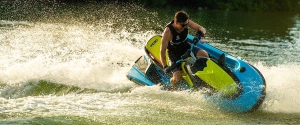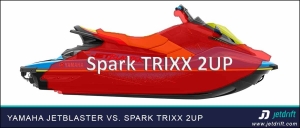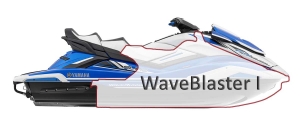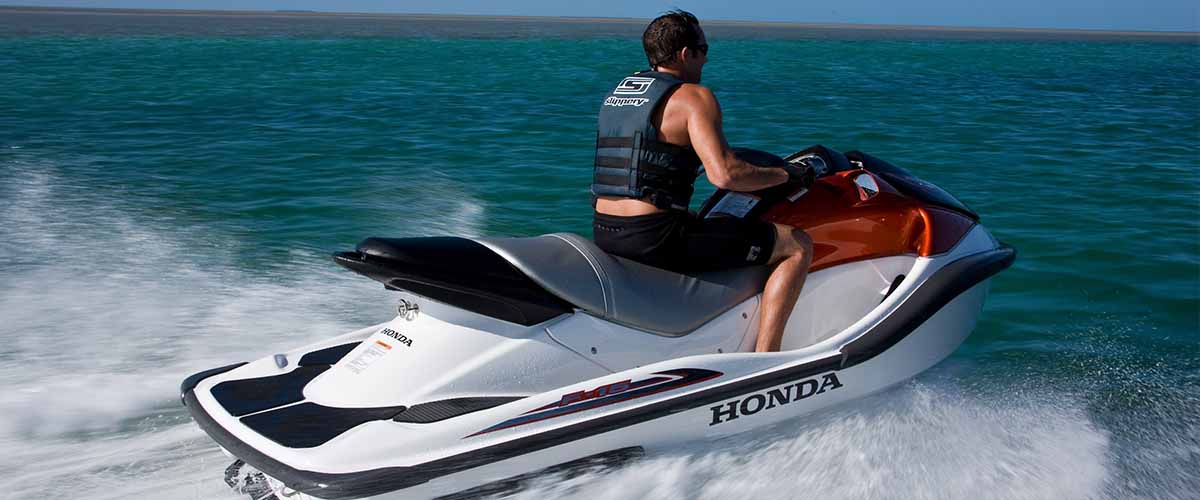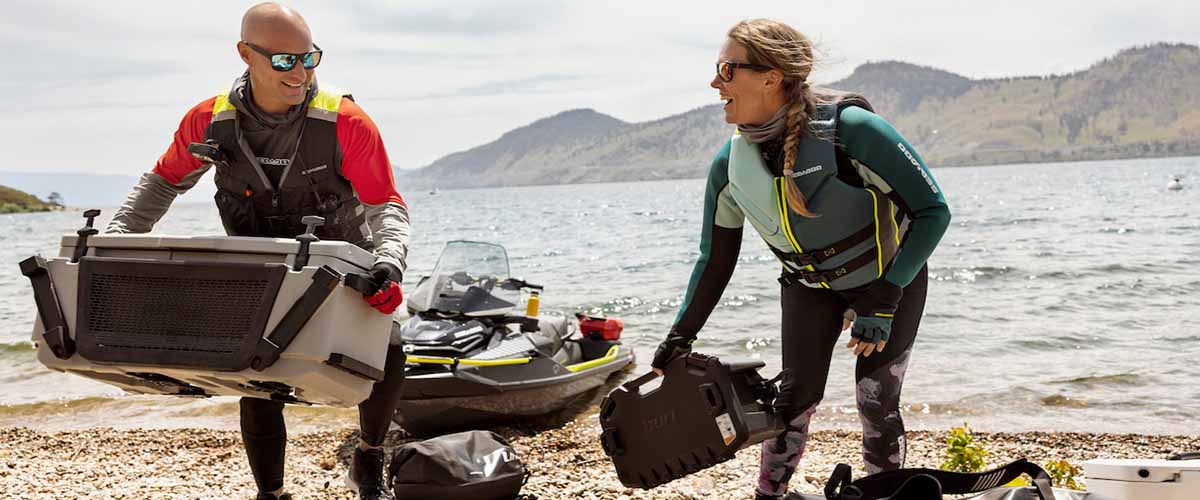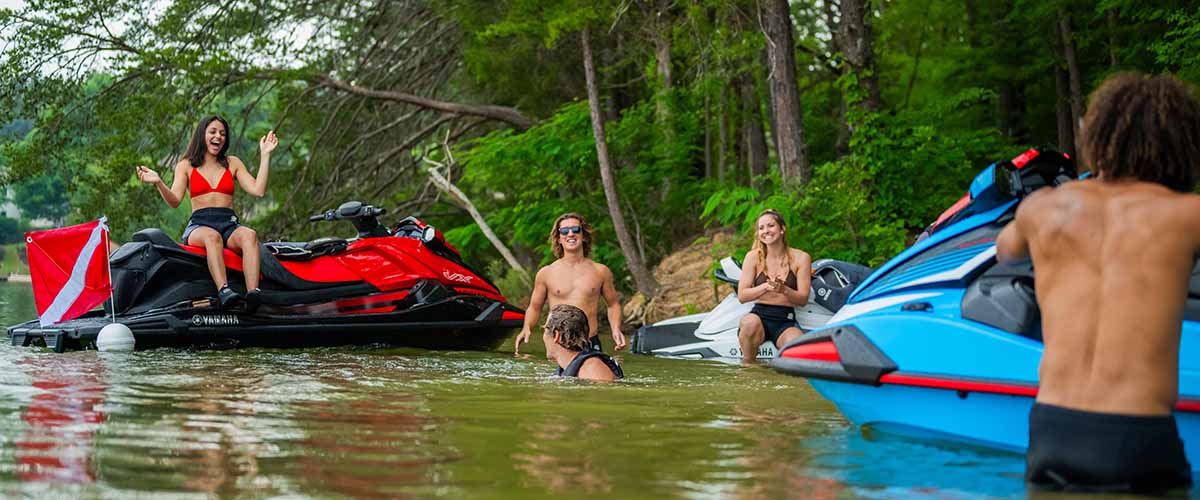Kawasaki Jet Mate Review and Specs [Video]
The legendary Kawasaki Jet Mate debuted in 1989 and was marketed through 1992. This unique vessel was virtually a mix of a tiny boat and a jet ski!
It was powered by a 635cc, 2-stroke twin that cranked out 56 HP and utilized a weird, tub-shaped hull.
If you want to find out more about this iconic Kawasaki PWC, you’ve come to the right place.
We at JetDrift have compiled all you need to know into this Kawasaki Jet Mate review!
1989-1992 Kawasaki Jet Mate Review
The Kawasaki Jet Mate hit the market in 1989 and got a lot of attention, as it was different from any other vessel out there. It featured a very small boat–like hull that was propelled by a Kawasaki jet ski pump.
Although it was officially labeled as a “passenger boat” due to its odd design, the Jet Mate earned many fun nicknames, including “Showroom Couches,” “Hot Tubs,” and “Water ATVs.”
The exact names of the different models were as follows:
- 1989 Kawasaki Jet Mate: Model JB650-A1
- 1990 Kawasaki Jet Mate: Model JB650-A2
- 1991 Kawasaki Jet Mate: Model JB650-A3
- 1992 Kawasaki Jet Mate: Model JB650-A4
Each model shared the same surprisingly short fiberglass hull, which was only 106.7 inches long, 60.2 inches wide, and 30.3 inches high.
No, it’s not a typo; the Jet Mate was shorter than any of today’s jet skis! It was even 13.3 inches shorter than the smallest modern PWC, the 2-seater Sea-Doo Spark.
Thanks to its low, 12-inch draft, excellent maneuverability, and safe jet propulsion system, these versatile vessels were commonly used as rescue and patrol boats.
However, riding them in shallow water was always risky, as the jet pumps could be easily clogged up by debris and seaweed. And unclogging a jet pump on a boat is always a hassle!
This custom Kawasaki “jet ski” was not only extremely small, but its dry weight was only 527 pounds so that it could be towed by any car.
Its open cabin housed a single front seat with a foldable backrest and a rear bench for two passengers. The engine was placed beneath the driver’a seat while the fuel tank and the battery were mounted under the rear bench.
Regarding power source, the Jet Mate inherited its engine and jet pump from the Kawasaki 650SX stand-up jet ski. This 2-stroke, 635cc, 2-cylinder engine cranked out 52 HP at 6000 RPM while the single axial-flow jet pump delivered 507 lbs. of thrust.
The maximum load capacity of this tiny machine was three riders or 480 pounds and it could hold 13.2 gallons of gas. Since the fuel economy of the Jet Mate was about 5 GPH, its fuel tank offered about two and a half hours of play.
According to this review, the top speed of the Jet Mate was about 30 mph under ideal conditions.
Surprisingly, the machine was controlled with a joystick rather than a regular handlebar or steering wheel. This joystick was intended for steering and speed control, but a separate system controlled the reverse.
Standard features included a bilge pump, built-in open storage compartments, a 13.2-gallon fuel tank, 1.45-gallon oil tank, a 12V battery, and a blower. The latter was intended to ventilate the engine compartment to get rid of the gas fumes. Although the craft featured large integrated handles on its top deck, they didn’t actually help in reboarding.
Because of this, you can see aftermarket reboarding steps or ladders on the stern of many vintage Jet Mates. Since its stern is completely flat, bolting reboarding steps on it is not an issue.
When it comes to the riding experience, many owners said that the Jet Mate was quite underpowered. Compared to stand-up jet skis, which topped out at 45-50 mph, this tiny boat was significantly slower, so it had little chance of hanging with other PWCs on the water.
Other major drawbacks of the Jet Mate were its boat-like seats, which offered comfortable rides only on glass-like water. Let’s face it, unlike heavy boats, lightweight personal watercrafts always offer bumpy rides on choppy water. This is why they are typically ridden in a standing position on choppy water.
The rider’s legs work like shock absorbers, which can effectively absorb dynamic effects. But due to its unique seating, riding a Jet Mate in a standing position was hard to impossible.
Consequently, riding them on choppy water often resulted in massive back pain. Moreover, since the bottom of this hull was nearly completely flat, it couldn’t cut the waves like the bigger hulls with a “deep-V” design.
On the other hand, this short and flat hull was capable of many “sit down” tricks like power slides and spins!
The Jet Mate was produced for four short years (‘89-‘92), and just about 1,200 of them were shipped to the U.S.
Despite this, you can still find some of these unique vessels running on the water. The lucky ones have been restored or even repowered with more powerful engines.
The most commonly used engine/pump setup in Jet Mates probably comes from the SX-R 800 stand-up jet ski, but it’s not uncommon to find 1000+cc engine swaps.
Kawasaki Jet Mate Specs Chart
For your convenience, we’ve listed the original Kawasaki Jet Mate specifications in these charts:
Kawasaki Jet Mate Engine Specs
| Engine Specs | |
|---|---|
| Type | 2-stroke, vertical twin, crankcase reed valve, water cooled |
| Displacement | 635 cc |
| Bore and Stroke | 76.0 x 70.0 mm |
| Compression Ratio | 7.2:1 |
| Maximum Horsepower | 52 HP (38.2 kW) @ 6000 r/min (rpm) |
| Maximum Torque | 64.7 N-m (6.6 kg·m. 47.7 ft-lb) @5500 r/min (rpm) |
| Ignition | Magneto CDI |
| Lubrication System | Oil injection (break-in period: Oil injection and fuel mixture 50:1) |
| Carburetor | Keihin CDK34 diaphragm type (28 mm venturi) |
| Starting System | Electric Starter |
| Spark Plug | NGK BR7ES |
| Spark Plug Gap | 0.7 - 0.8 mm |
| Ignition Timing | 17° BTDC @6 000 r/min (rpm), 2.0 mm @6 000 r/min (rpm) |
| Idle Speed - In water | 1 250 ±100 r/min (rpm) |
| Idle Speed - Out of water | 1800 ± 100 r/min (rpm) |
| Compression Pressure | 865 -1325 kPa (8.8 -13.5 kg/cm2, 125 - 192 psi |
Kawasaki Jet Mate Dimension Chart
| Dimension | |
|---|---|
| Length | 106.7 in (2710 mm) |
| Width | 60.2 in (1525 mm) |
| Height | 30.3 in (770 mm) |
| Dry Weight | 527 lbs (239 kg) |
| Fuel Tank Capacity | 7.93 gal (30 L including 4 L reserve) |
| Engine Oil Type | 2-stroke, N.M.M.A. Certified for Service TC-W |
| Engine Oil Tank Capacity | 1.45 gal (5.5 L) |
| Maximum Capacity | 3 persons, @ 3 persons or 218 kg (480 Ib) |
| Minimum Turning Radius | 82.7 in (2.1 m) |
| Draft (Stationary) | 310 mm |
| Fuel Consumption | 5 gal (19 L)/h @full throttle |
Kawasaki Jet Mate Propulsion
| Propulsion | |
|---|---|
| Coupling | Direct drive from engine |
| Jet Pump: Type | Axial flow, single stage |
| Jet Pump: Thrust | 2 260 N (230 kg, 507 Ib) |
| Steering | Steerable nozzle |
| Braking | Water drag |
Kawasaki Jet Mate Electric Chart
| Electric Chart | |
|---|---|
| Battery | 12 V 50 Ah (20-hour rate) / 40 Ah (5-hour rate) |
| Maximum Generator Output | 8 A/14 V@ 5000 r/min (rpm) |
These charts are for informational purposes only! For exact specifications, please refer to the factory manual.
Takeaway
As a takeaway, we’ve answered the most common questions about the Kawasaki Jet Mate.
What Year did the Kawasaki Jet Mate Come Out?
Kawasaki introduced the legendary Jet Mate in 1989.
What Years was the Kawasaki Jet Mate Made?
The Kawasaki Jet Mate was manufactured from 1989 to 1992, and only 1,200 of them were shipped to the U.S.
What Size was the Kawasaki Jet Mate?
The boat-like hull of the Jet Mate was only 106.7 inches long, 60.2 inches wide, and 30.3 inches high.
How Much Did a Kawasaki Jet Mate Weigh?
The dry weight of the tiny Kawasaki Jet Mate was only 527 pounds.
What Kind of Engine was in the Kawasaki Jet Mate?
The Kawasaki Jet Mate was powered by a 635cc 2-stroke twin and utilized a single axial-flow jet pump. Both were borrowed from the popular 650-class stand-up jet skis.
How Much Horsepower Did a Kawasaki Jet Mate Have?
According to the official user’s manual, the Kawasaki Jet Mate produced 52 HP.
How Fast Could a Kawasaki Jet Mate Go?
Sadly, the Jet Mate was quite underpowered, as its top speed was only about 30 mph under ideal conditions.
How Much Does a Kawasaki Jet Mate Cost?
Since they are already collectible items, the prices of Kawasaki Jet Mates have skyrocketed. If you are looking for a restored one, be prepared to pay about $3,500-$4,000. In contrast, Jet Mates in poor condition cost about $1,000-$1,500 depending on their condition and the location.
DISCOVER 2024 PWC MODELS Kawasaki, Sea-Doo, Yamaha, Krash…

